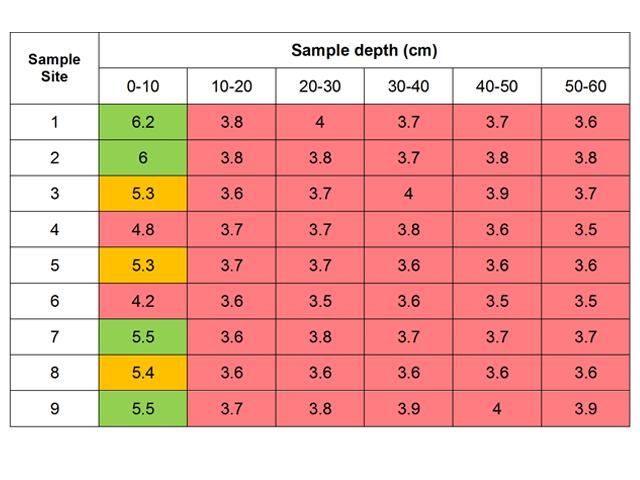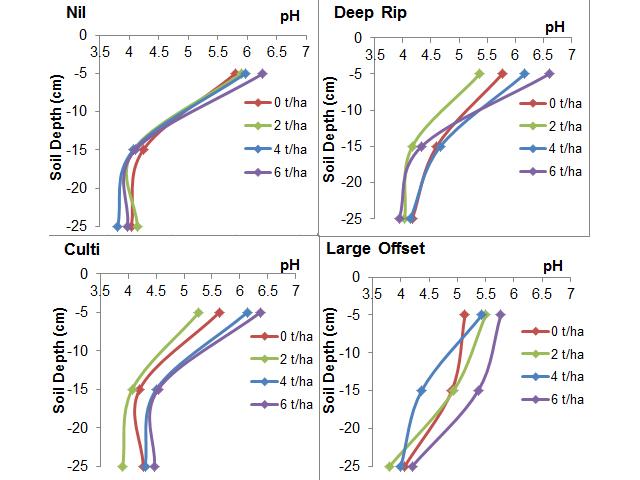Background
Until recently the most common rate of agricultural lime application is one tonne per hectare as a blanket application across the surface of the whole paddock (Taking soil acidity seriously - results of grower surveys 2012, page 118).
This amount is often insufficient to recover and maintain soils above recommended targets of pH 5.5 and 4.8 in topsoil and subsoil, respectively.
A 2015 phone survey of 20 growers, conducted by this project, found teh majority of growers are now using 2t/ha lime in order to speed the repair of soils.
As a result of Caring for Country project SP11-01226, growers in Western Australia are increasingly testing pH of soils below 10cm.
Growers understand the importance of lime in restoring soil pH, as seen by the increase in sales of lime in the northern wheatbelt (Liebe group technical audit results 2012).
Preliminary work by Davies, 2012 (Developing and assessing agronomic strategies for water repellent soils, page 71) has shown the applicability of a number of innovative techniques, including mouldboard ploughing and rotary spading, for incorporation of lime to depth.
Lime on the topsoil can be incorporated to a depth of 30cm enabling management of pH at this depth.
This trial is one of six similar trials throughout the northern wheatbelt. It will help establish best practice methods and promote the effectiveness of these techniques throughout the rainfall zones of the northern agricultural region (NAR).
Aim
To showcase to growers different methods for deep incorporation of lime to ameliorate sub surface, below 10cm, acidity and improve soil health.
Trial details
| Property | Blackburn, Latham |
|---|---|
| Soil type | Acid sand with gravel at depth |
| Crop / variety | Wheat |
| Paddock rotation | 2014 pasture/fallow, 2015 wheat |
| Treatments | 2015 lime: 0,2 ,4.5t/ha |
| 2015 incorporation: Nil (minimum tillage knife poinsts presswheels, 36" Grizzly offset plough, Gessner Maxitil deep ripper, John Deere 1810 bar with cultivator points | |
| Replicates | Four |
| Growing season rainfall (DAFWA Latham station) | January–March 104mm April–September 213mm |
Results
Note; pH discussed as pH (1:5 CaCl2)

| Incorporation method | Plants /m2 | Heads/m2 | Estimated heads/plant |
|---|---|---|---|
| Nil | 74 | 146 | 1.97 |
| Cultivator point | 91 | 163 | 1.75 |
| Deep rip | 68 | 174 | 2.56 |
| Grizzly 36" offset | 46 | 140 | 3.04 |

Comments
The soil at the Latham site is referred to as an acid Wodjil, brown sand with increasing gravel with depth. These soils were naturally highly acidic before agriculture. Both exchangeable aluminium and acidity levels increase with depth (table 1). The poor production from this paddock means that it is not cropped every year and often left to volunteer pasture. It was pasture in 2014 and cropped in 2015.
In 2015, the year of the demonstration, wheat yield was not significantly influenced by lime or incorporation (figure 2).
There is a soil compaction layer peaking at 30cm, though roots are impeded from 10cm (figure 1). Both deep ripping and large offset disc disrupted this layer though no post ripping measurements were taken. Acidity, and the likely aluminium toxicity, are the major constraints at this site. Breaking the compaction layer did little to improve the yield.
Emergence was heavily influenced by the incorporation method. Plants in the Grizzly 36" offset were a week behind the remainder of the trial in emergence. Grizzly Tiny® plots were sown deeper and had significantly less plants/m2 which negatively influenced yield for this treatment. The topsoil became toxic, and slowed emergence, with acid sub-surface brought up by the large offset disc. Surface crusting of the offset disc treatments further detracted from the number of plants emerging. The plants within these treatments went on to tiller very well, with large head size, though not sufficiently to make up yield lost to low plant numbers (Table 2).
There is limited soil movement, therefore limited incorporation, from the Deep Rip and Cultivator point treatments (figure 3). Only small levels of lime incorporation are expected with the current set up of these implements. It is possible to modify the deep ripper to incorporate topsoil to depth, in a narrow band, by adding opener plates behind the tine (refer to work of Isbister and Blackwell, SEPWA newsletter issue 74, June 2015 page 18).
The large offset disc has moved a lot of soil to a depth of approximately 23cm. Bringing acidity to the surface and burying lime to depth. It is likely to have the greatest influence on sub-surface pH into the future. Precision Soil Tech tested the soils and recommended 6t/ha of lime to rectify the soil acidity issues. We speculate that these plots will be the highest yielding plots in future years.
Acknowledgements
Thanks to Wes Benton and Chad McKay, for managing the trial; also to DAFWA technical services staff for their assistance and SoilTech for soil sampling.
This project is supported by the Northern Agricultural Catchments Council, through funding from the Australian Government’s National Landcare Programme.
